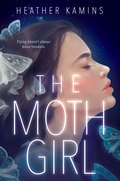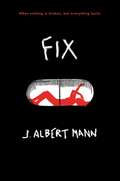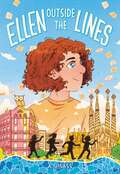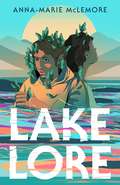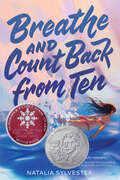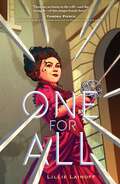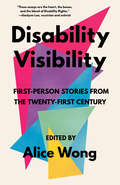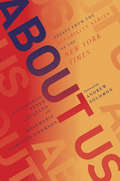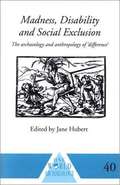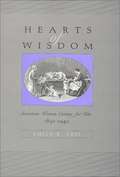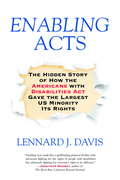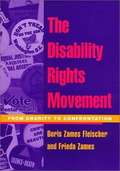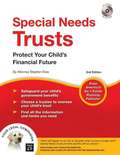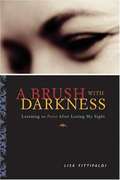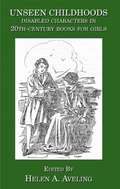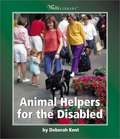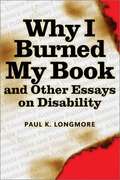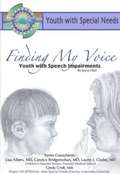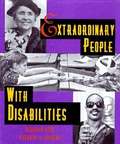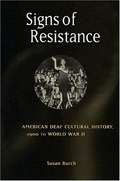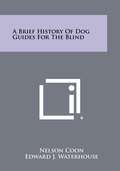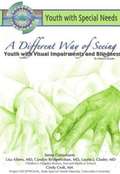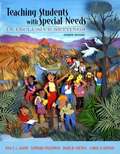Special Collections
Disability Collection
Description: Bookshare is pleased to offer a collection focused on the topic of disability and accessibility. #disability
- Table View
- List View
The Moth Girl
by Heather KaminsFlying doesn&’t always mean freedom. Anna is a regular teenaged girl. She runs track with her best friend, gets good grades, and sometimes drinks beer at parties. But one day at track practice, Anna falls unconscious . . . but instead of falling down, she falls up, defying gravity in the disturbing first symptom of a mysterious disease. This begins a series of trips to the hospital that soon become Anna&’s norm. She&’s diagnosed with lepidopsy: a rare illness that causes symptoms reminiscent of moths: floating, attraction to light, a craving for sugar, and for an unlucky few, more dangerous physical manifestations. Anna&’s world is turned upside down, and as she learns to cope with her illness, she finds herself drifting further and further away from her former life. Her friends don&’t seem to understand, running track is out of the question, and the other kids at the disease clinic she attends once a week are a cruel reminder that things will never be the same. From debut author Heather Kamins comes a beautiful and evocative story about one girl&’s journey of choosing who she wants to be--in a life she never planned for.
Fix
by J. Albert MannIn this gritty, heart-wrenching mystery, prose and verse mix to explores themes of disability, pain, belonging, loss, addiction, and friendship.Everything was fine before. When Eve and Lidia could hide their physical differences inside goofy Burger Hut costumes. When Lidia shook Eve up and Eve made Lidia laugh. When Lidia was there. Everything is different now. Cut open . . . rearranged . . . stapled shut, Eve is left alone to recover in a world of pain and a body she no longer recognizes. Her only companions being a bottle of Roxanol and an infuriating (but cute) neighbor, Eve strikes up a relationship—and makes a pact—with the devil. Sacrificing pieces of a place she doesn't know to return to a place she does. What will she discover when she unravels her past? And is having Lidia back worth the price? In verse and prose, Fix paints a riveting picture of a teen struggling to find herself and move forward with her life in a sea of opioids, regret, grief, and hope.
Ellen Outside the Lines
by A. J. SassWinner of a Sydney Taylor Book Award Honor! A heartfelt novel about a neurodivergent thirteen-year-old navigating changing friendships, a school trip, and expanding horizons for fans of Rain Reign and Ivy Aberdeen's Letter to the World. Thirteen-year-old Ellen Katz feels most comfortable when her life is well planned out and people fit neatly into her predefined categories. She attends temple with Abba and Mom every Friday and Saturday. Ellen only gets crushes on girls, never boys, and she knows she can always rely on her best-and-only friend, Laurel, to help navigate social situations at their private Georgia middle school. Laurel has always made Ellen feel like being autistic is no big deal. But lately, Laurel has started making more friends, and cancelling more weekend plans with Ellen than she keeps. A school trip to Barcelona seems like the perfect place for Ellen to get their friendship back on track. Except it doesn't. Toss in a new nonbinary classmate whose identity has Ellen questioning her very binary way of seeing the world, homesickness, a scavenger hunt-style team project that takes the students through Barcelona to learn about Spanish culture and this trip is anything but what Ellen planned. Making new friends and letting go of old ones is never easy, but Ellen might just find a comfortable new place for herself if she can learn to embrace the fact that life doesn't always stick to a planned itinerary.
Lakelore
by Anna-Marie McLemoreIn this young adult novel by award-winning author Anna-Marie McLemore, two non-binary teens are pulled into a magical world under a lake - but can they keep their worlds above water intact? Everyone who lives near the lake knows the stories about the world underneath it, an ethereal landscape rumored to be half-air, half-water. But Bastián Silvano and Lore Garcia are the only ones who’ve been there. Bastián grew up both above the lake and in the otherworldly space beneath it. Lore’s only seen the world under the lake once, but that one encounter changed their life and their fate.Then the lines between air and water begin to blur. The world under the lake drifts above the surface. If Bastián and Lore don’t want it bringing their secrets to the surface with it, they have to stop it, and to do that, they have to work together. There’s just one problem: Bastián and Lore haven’t spoken in seven years, and working together means trusting each other with the very things they’re trying to hide.
Breathe and Count Back from Ten
by Natalia SylvesterIn this gorgeously written and authentic novel, Verónica, a Peruvian-American teen with hip dysplasia, auditions to become a mermaid at a Central Florida theme park in the summer before her senior year, all while figuring out her first real boyfriend and how to feel safe in her own body.Verónica has had many surgeries to manage her disability. The best form of rehabilitation is swimming, so she spends hours in the pool, but not just to strengthen her body.Her Florida town is home to Mermaid Cove, a kitschy underwater attraction where professional mermaids perform in giant tanks . . . and Verónica wants to audition. But her conservative Peruvian parents would never go for it. And they definitely would never let her be with Alex, her cute new neighbor.She decides it’s time to seize control of her life, but her plans come crashing down when she learns her parents have been hiding the truth from her—the truth about her own body.
One for All
by Lillie Lainoff“There are no limits to the will—and the strength—of this unique female hero.” —Tamora Pierce, writer of the Song of the Lioness and the Protector of the Small quartetsOne for All is a gender-bent retelling of The Three Musketeers, in which a girl with a chronic illness trains as a Musketeer and uncovers secrets, sisterhood, and self-love.Tania de Batz is most herself with a sword in her hand. Everyone thinks her near-constant dizziness makes her weak, nothing but “a sick girl.” But Tania wants to be strong, independent, a fencer like her father—a former Musketeer and her greatest champion. Then Papa is brutally, mysteriously murdered. His dying wish? For Tania to attend finishing school. But L’Académie des Mariées, Tania realizes, is no finishing school. It’s a secret training ground for new Musketeers: women who are socialites on the surface, but strap daggers under their skirts, seduce men into giving up dangerous secrets, and protect France from downfall. And they don’t shy away from a sword fight.With her newfound sisters at her side, Tania feels that she has a purpose, that she belongs. But then she meets Étienne, her target in uncovering a potential assassination plot. He’s kind, charming—and might have information about what really happened to her father. Torn between duty and dizzying emotion, Tania will have to decide where her loyalties lie…or risk losing everything she’s ever wanted.Lillie Lainoff's debut novel is a fierce, whirlwind adventure about the depth of found family, the strength that goes beyond the body, and the determination it takes to fight for what you love. Includes an author's note about her personal experience with Postural Orthostatic Tachycardia Syndrome.
Disability Visibility
by Alice Wong&“Disability rights activist Alice Wong brings tough conversations to the forefront of society with this anthology. It sheds light on the experience of life as an individual with disabilities, as told by none other than authors with these life experiences. It's an eye-opening collection that readers will revisit time and time again.&” —Chicago TribuneOne in five people in the United States lives with a disability. Some disabilities are visible, others less apparent—but all are underrepresented in media and popular culture. Activist Alice Wong brings together this urgent, galvanizing collection of contemporary essays by disabled people, just in time for the thirtieth anniversary of the Americans with Disabilities Act,From Harriet McBryde Johnson&’s account of her debate with Peter Singer over her own personhood to original pieces by authors like Keah Brown and Haben Girma; from blog posts, manifestos, and eulogies to Congressional testimonies, and beyond: this anthology gives a glimpse into the rich complexity of the disabled experience, highlighting the passions, talents, and everyday lives of this community. It invites readers to question their own understandings. It celebrates and documents disability culture in the now. It looks to the future and the past with hope and love.
About Us
by Rosemarie Garland-Thomson and Peter CatapanoBased on the pioneering New York Times series, About Us collects the personal essays and reflections that have transformed the national conversation around disability.
Boldly claiming a space in which people with disabilities can be seen and heard as they are—not as others perceive them—About Us captures the voices of a community that has for too long been stereotyped and misrepresented. Speaking not only to those with disabilities, but also to their families, coworkers and support networks, the authors in About Us offer intimate stories of how they navigate a world not built for them. Since its 2016 debut, the popular New York Times’ “Disability” column has transformed the national dialogue around disability. Now, echoing the refrain of the disability rights movement, “Nothing about us without us,” this landmark collection gathers the most powerful essays from the series that speak to the fullness of human experience—stories about first romance, childhood shame and isolation, segregation, professional ambition, child-bearing and parenting, aging and beyond.
Reflecting on the fraught conversations around disability—from the friend who says “I don’t think of you as disabled,” to the father who scolds his child with attention differences, “Stop it stop it stop it what is wrong with you?”—the stories here reveal the range of responses, and the variety of consequences, to being labeled as “disabled” by the broader public.
Here, a writer recounts her path through medical school as a wheelchair user—forging a unique bridge between patients with disabilities and their physicians. An acclaimed artist with spina bifida discusses her art practice as one that invites us to “stretch ourselves toward a world where all bodies are exquisite.” With these notes of triumph, these stories also offer honest portrayals of frustration over access to medical care, the burden of social stigma and the nearly constant need to self-advocate in the public realm.
In its final sections, About Us turns to the questions of love, family and joy to show how it is possible to revel in life as a person with disabilities. Subverting the pervasive belief that disability results in relentless suffering and isolation, a quadriplegic writer reveals how she rediscovered intimacy without touch, and a mother with a chronic illness shares what her condition has taught her young children. With a foreword by Andrew Solomon and introductory comments by co-editors Peter Catapano and Rosemarie Garland-Thomson, About Us is a landmark publication of the disability movement for readers of all backgrounds, forms and abilities.
Topics Include: Becoming Disabled • Mental Illness is not a Horror Show • Disability and the Right to Choose • Brain Injury and the Civil Right We Don’t Think • The Deaf Body in Public Space • The Everyday Anxiety of the Stutterer • I Use a Wheelchair. And Yes, I’m Your Doctor • A Symbol for “Nobody” That’s Really for Everybody • Flying While Blind • My $1,000 Anxiety Attack • A Girlfriend of My Own • The Three-Legged Dog Who Carried Me • Passing My Disability On to My Children • I Have Diabetes. Am I to Blame? • Learning to Sing Again • A Disabled Life is a Life Worth Living
Madness, Disability and Social Exclusion
by Jane HubertA unique work that brings together a broad range of specialist disciplines to create a new perspective on social and physical exclusion from society. Brings a much needed comparative approach to the subject of disability. Confinement, hermaphrodites, killing of disabled children, leprosy, deafness, and funerary rituals are explored.
Hearts of Wisdom
by Emily K. AbelDrawing upon a wealth of diaries, letters, and case records from hospitals and social service agencies, the author examines the shifting roles of caregivers between 1850 and 1940. In addition to the diaries and letters of literate white woman, she turns to slave narratives from the antebellum south and records from health-care agencies serving American Indians during the first part of the 20th century. Abel shows that women in the 19th century gained self-esteem and status through their knowledge of home remedies and nursing techniques. The medical profession gained strength with the discovery of microbes and the development of medications to treat specific diseases. During the 20th century professionals discredited women who provided health care at home. One chapter discusses mothers of children with epilepsy or mental retardation, who were pressured to place their children in institutions and to sever emotional ties with them. Another chapter explores the shift from American sign language to oralism in the education of deaf children, and the impact this had upon mothers. Abel concludes by looking briefly at the current trend to return more and more caregiving to the home.
Enabling Acts
by Lennard J. DavisThe first significant book on the history and impact of the ADA--the "eyes on the prize" moment for disability rights.
The Americans with Disabilities Act (ADA) is the widest-ranging and most comprehensive piece of civil rights legislation ever passed in the United States, and it has become the model for disability-based laws around the world. Yet the surprising story behind how the bill came to be is little known.
In this riveting account, acclaimed disability scholar Lennard J. Davis delivers the first behind-the-scenes and on-the-ground narrative of how a band of leftist Berkeley hippies managed to make an alliance with upper-crust, conservative Republicans to bring about a truly bipartisan bill.
Based on extensive interviews with all the major players involved including legislators and activists, Davis recreates the dramatic tension of a story that is anything but a dry account of bills and speeches. Rather, it's filled with one indefatigable character after another, culminating in explosive moments when the hidden army of the disability community stages scenes like the iconic "Capitol Crawl" or an event some describe as "deaf Selma," when students stormed Gallaudet University demanding a "Deaf President Now!"
From inside the offices of newly formed disability groups to secret breakfast meetings surreptitiously held outside the White House grounds, here we meet countless unsung characters, including political heavyweights and disability advocates on the front lines. "You want to fight?" an angered Ted Kennedy would shout in an upstairs room at the Capitol while negotiating the final details of the ADA. Congressman Tony Coelho, whose parents once thought him to be possessed by the devil because of his epilepsy, later became the bill's primary sponsor. There's Justin Dart, adorned in disability power buttons and his signature cowboy hat, who took to the road canvassing fifty states, and people like Patrisha Wright, also known as "The General," Arlene Myerson or "the brains," "architect" Bob Funk, and visionary Mary Lou Breslin, who left the hippie highlands of the West to pursue equal rights in the marble halls of DC.
Published for the twenty-fifth anniversary of the ADA, Enabling Acts promises to ignite readers in a discussion of disability rights by documenting this "eyes on the prize" moment for tens of millions of American citizens.
The Disability Rights Movement
by Doris Z. Fleischer and Freida ZamesBased on interviews with almost a hundred activists, this book provides a detailed history of the struggle for disability rights in the United States. It is a complex story of shifts in consciousness and shifts in policy, of changing focuses on particular disabilities such as blindness, deafness, polio, quadriplegia, psychiatric and developmental disabilities, chronic conditions (for example, cancer and heart disease), AIDS, and of activism and policymaking across disabilities.
Referring to the Americans with Disabilities Act as "every American's insurance policy," the authors recount the genesis of this civil rights approach to disability, from the almost forgotten disability activism of the 1930s, to the independent living movement of the 1970s, to the call for disability pride of the 1990s. Like other civil rights struggles, the disability rights movement took place in the streets and in the courts as activists fought for change in the schools, the workplace, and in the legal system. They continue to fight for effective access to the necessities of everyday life-to telephones, buses, planes, public buildings, restaurants, and toilets.
The history of disability rights mirrors the history of the country. Each World War sparked changes in disability policy and changes in medical technology as veterans without limbs and with other disabilities returned home. The empowerment of people with disabilities has become another chapter in the struggles over identity politics that began in the 1960s.
Today, with the expanding ability of people with disabilities to enter the workforce and a growing elderly population, issues like longterm care are becoming increasingly significant at a time when HMOs are trying to contain health care expenditures.
Special Needs Trusts
by Stephen EliasIf you care for a child or other loved one with a disability, you've no doubt thought about what will happen when you're no longer able to give that care. Fortunately, there's a simple solution to this dilemma -- create a "special needs trust." Special Needs Trusts shows you how to leave any amount of money to your disabled loved one, without jeopardizing government benefits. It provides plain-English information and forms that let you create a special needs trust by modifying your will or living trust document.
A Brush With Darkness
by Lisa FittipaldiWhen Lisa Fittipaldi went blind at the age of forty-seven, she descended into a freefall of anger and denial that lasted for two years. In this moving memoir, she paints a vivid picture of the perceptual and emotional darkness that accompanied her vision loss, and her arduous journey back into the sighted world through mastery of the principles of art and color.
Unseen Childhoods
by Helen A. AvelingThe nine essays in this collection break the 20th century into three periods - early, middle, and late. They cover the themes of stereotypes, role models, and inclusion and segregation, tracing their evolution across nearly a hundred years. Among the essays are "Modeling Illness in the Early 20th Century" by Helen A. Aveling; "A Choice of Virtues," by Deborah Kent; and "My Sibling the Other," by Rebecca R. Butler.
Animal Helpers for the Disabled
by Deborah KentWritten for children in the middle grades, this book gives a brief history of the assistance-dog movement and the many ways in which dogs (as well as, in some instances, other animals) work as partners with people with disabilities. Chapters explore how assistance dogs are trained, living with an assistance dog, and legislation regarding access to public accommodations.
The Learning Disabled Child
by Suzanne H. StevensStevens gives parents what they need to determine whether or not their child has a learning disability. She then provides tips to help parents navigate the public school system in order to obtain help. She also presents adaptive techniques, discusses the therapies which are available and what they can do. She asks parents the tough questions which need to be answered if a learning-disabled child is to succeed in a regular classroom and adapt successfully to the disability. Clear, concises, informative, upbeat, practical.
Why I Burned My Book And Other Essays On Disability
by Paul K. LongmoreThis wide-ranging book shows why Paul Longmore is one of the most respected figures in disability studies today. Understanding disability as a major variety of human experience, he urges us to establish it as a category of social, political, and historical analysis in much the same way that race, gender, and class already have been. The essays here search for the often hidden pattern of systemic prejudice and probe into the institutionalized discrimination that affects the one in five Americans with disabilities.
Whether writing about the social critic Randolph Bourne, contemporary political activists, or media representations of people with disabilities, Longmore demonstrates that the search for heroes is a key part of the continuing struggle of disabled people to gain a voice and to shape their destinies. His essays on bioethics and public policy examine the conflict of agendas between disability rights activists and non-disabled policy makers, healthcare professionals, euthanasia advocates, and corporate medical bureaucracies.
The title essay, which concludes the book, demonstrates the necessity of activism for any disabled person who wants access to the American dream.
Author note: Paul K. Longmore is Professor of History at San Francisco State University. He is the author of The Invention of George Washington and the co-editor (with Lauri Umansky) of The New Disability History: American Perspectives.
Finding My Voice
by Joyce LibalSpeech impairment is a common challenge among youth. Unfortunately, it is a challenge that, despite its frequency, can cause severe emotional and social distress for those who experience it. Stigma and prejudice can present particularly difficult emotional trials and social roadblocks to youth with speech impairments. All too often, these young people are assumed to be less capable, immature, or even unintelligent because of their communication barriers.
Extraordinary People with Disabilities
by Deborah Kent and Kathryn A. QuinlanThis book tells the stories of 54 historical figures with disabilities. From people who were known for their disability like Helen Keller, Stevie Wonder and Heather Whitestone to people who made an impact on the world and not just amongst the disabled community, like FDR, Harriet Tubman and Thomas Edison. In addition to the biographies there are short histories of legislation that changed history for Americans with Disabilities.
Signs of Resistance
by Paul K. Longmore and Lauri Umansky and Susan BurchDuring the early nineteenth century, American schools for deaf education regarded sign language as the "natural language" of deaf people, using it as the principal mode of instruction and communication. These schools inadvertently became the seedbeds of an emerging Deaf community and culture. But by mid-century, an oralist movement developed that sought to suppress sign language, removing Deaf teachers and requiring deaf people to learn speech and lip reading. Historians have all assumed that in the early decades of the twentieth century oralism triumphed overwhelmingly.
Susan Burch shows us that everyone has it wrong; Deaf students, teachers, and staff consistently and creatively subverted oralist policies and goals within the schools. Ultimately, the efforts to assimilate Deaf people resulted in fortifying their ties to a separate Deaf cultural community.
In Signs of Resistance, Susan Burch persuasively reinterprets early twentieth century Deaf history. Using community sources such as Deaf newspapers, memoirs, films, and oral (sign language) interviews, Burch shows how the Deaf community mobilized to defend sign language, increased its political activism, and clarified its cultural values. In the process, a collective Deaf consciousness, identity, and political organization were formed.
A Brief History of Dog Guides for the Blind
by Nelson CoonThis small book originally an article written by the reference librarian at the Blindiana Library at Perkins School for the Blind highlights the varied and long history of dog guides for blind people. From Pompae, to Japan, from the 15th centure to biblical times the author depicts and writes about dogs guiding blind people. Illustrated with descriptive paintings and texts from various books, this book is a treasure for anyone who loves dogs, and or history.
A Different Way of Seeing
by Patricia SouderKyla passed the ball to her teammate, then raced up the court. Somehow, she lost track of the orange globe and didn't see it again until right before it smashed into her left cheek. Kyla's head snapped. At courtside, a paramedic asked her to close her left eye and see with her right. "How's everything look?" "Just fine." The paramedic instructed her to close her right eye and look with her left. "How about now?" "I see bright, flashing lights, some black specks, and a dark cloud right where you should be." "In that case, you win some eye shields and a trip to the emergency room." In A Different Way of Seeing: Youth with Visual Impairments and Blindness, you will learn about many different visual disorders, what can cause them, and resources to help deal with the challenges visual impairments can bring. As you follow Kyla's story, you will learn what it is like to be visually impaired. Along the way, you will also learn about the resources and adaptive devices - like white canes, guide dogs, Braille, blind camps, music programs, and sports opportunities - available to help youth with blindness or vision impairment. People with vision impairments have many stories to tell - stories of determination, hope, and accomplishment.
Teaching Students with Special Needs
by Tom E. C. Smith and Edward A. Polloway and James R. Patton and Carol A. Dowdythe one thing that will remain constant is the commitment to provide all students, regardless of their abilities or disabilities, with an equal opportunity to receive an appropriate education.
Looking Beyond Limitations
by Joan Kilbourne and Steve KöehmstedtAn investigation into the ways in which educational institutions disable students with learning disabilities.
